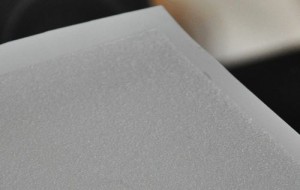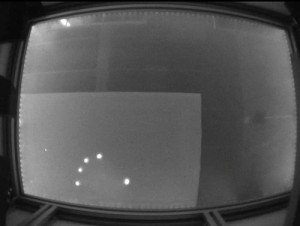Inspired by a post on NUI Group Community Forums by Tinkerman I decided to give FTIR (to be accurate, a combination of DSI and FTIR.) a try, creating my first owncompliant surface. The described technique of applying a layer of silicone to a projection surface seemed to be much easier than other methods, such as pouring silicone directly on the acrylic sheet.
To get started, I got hold of the following items:
- Drafting film (waterproof, not requiring an additional protective layer)
- General purpose clear silicone (cheap stuff)
- Foam roller (to actually apply the silicone)
I applied a single layer of silicone to the drafting film, using the foam roller, and let it dry overnight. I did not use any thinner but the silicone as it comes out of the tube.

The result definitely exceeded my exceptions! I put the newly created compliant surface onto my EndLighten acrylic – et voilá! Bright blobs became visible wherever I touched the surface; and none of the contacts got stuck on the surface. Just to do a little experiment I added another layer of silicone – but I couldn’t tell any difference.
The only disadvantage I can see so far is that the drafting film is not as great of a projection surface as the rear-projection acrylic I was using before. Also, some stripes caused by the roller a visible (a wider roller would improve the result).

Hi Dominik,
Nice work with the FTIR multitouch. I’m looking at various methods of putting together a homebrew surface. Where did you order your Endlighten Acrylic from? As I’ve not found anywhere in the UK that stocks it.
I also like the work you’re doing with WP7.
All the best,
Nick
Hi Nick,
thanks for your comments! I ordered the Endlighten Acrylic from Evonik in Germany actually.
Regards,
Dominik
Hey dominik,
I’m building a DSI Multitouch table, all complete but I am not getting perfect blobs as I wanted.
I’ve thought in merging the two techniques (DSI/FTIR) but I’m 17 years old and my parents are supporting all the costs >1000euros, so I didn’t give try to do it.
But I’m able to do it if I have almoet the certain that it will work better than only DSI.
What can you tell me about the merge? Is it better use the complaint layer or rear projection?
Thanks, by the way great setup your DSI.
Hi Antonio,
thanks for your comment! What exactly do you mean by merging FTIR and DSI – adding a compliant layer? This will definitely make finger touches more visible; still, the contrast won’t reach that of FTIR. I don’t understand why you would have to choose between compliant layer and rear projection – they can be combined.
Hope this helps,
Dominik
Hey Dominik again,
Yeah you’re right. Silly mistake here.
I’m going to use RP and Complaint layer together.
Do you know if using the complaint layer it affects fiducials or it even helps?
Hi Dominik, you are doing good job and this helped me a lot. I want to make a surface like this. How did you apply the compliant surface. I want to know the material information you have used…
Thank You!
Regards:
Arslan
Hi Arslan,
The materials I used are listed above: general purpose bathroom silicone and a waterproof drafting film. I also described above how I applied the silicone.
Best,
Dominik